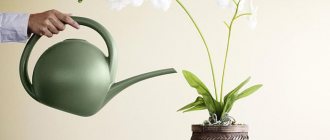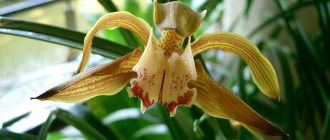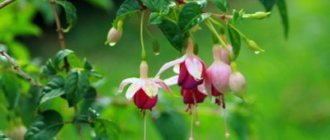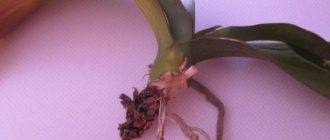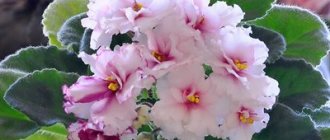Dracaena is an exotic and decorative “palm” of the Asparagus family, which grows on average up to 15 centimeters upward per year. People call it the dragon tree.
Dracaena is native mainly to Africa, southern Asia and Central America.
The plant is evergreen with a smooth, straight trunk, its appearance is very similar to a palm tree. The leaves are narrow and long with sharp tips. The leaves are green only in the upper part of the stem; in the lower part they gradually dry out and fall off. An indoor palm grows up to a maximum height of 50 centimeters.
There are several varieties of home dracaena:
- marginata;
- bamboo of happiness;
- fragrant.
In order for a plant to decorate the interior, it needs proper care:
- most types of palm trees are unpretentious and grow well in a room with high humidity (in summer the room temperature should be from 20 to 25 degrees, in winter it should not fall below 15 degrees);
- The plant loves daylight, but direct sunlight should be avoided. A good location is a west or east window. In winter, dracaena needs additional lighting;
- Any soil is suitable for good growth; it is best to place drainage in the pot;
- avoid drafts and cold rooms;
- in the summer you can put it on the balcony;
- do not forget to replant the plant on time. Once every three years (young shoots once a year, an adult palm once every five years).
Recommendations for watering dracaena
How to water dracaena correctly?
- During the growth period, it is watered once a week.
- In winter, it is recommended to irrigate the soil twice a month.
- Soften the water before watering with alkaline acid.
- To prevent the plant from growing upward, cut off the top.
- Remove yellowed leaves.
The secret to good growth and beautiful greenery of dracaena is ideal care; the soil should not be dry or too damp.
Signs of poor hydration
Dracaena is extremely sensitive to watering regime.
Any violations immediately affect her condition. Symptoms of improper water application:
- the leaf blades have drooped, drooped, the tips have dried out and turned yellow (lack of water);
- leaves curl, some elements fall off, become dull (lack of moisture);
- the trunk becomes soft, dark spots appear on it, a damp, putrid smell can be heard from the pot and from the plant itself, the leaves soften (overflow).
How to properly water dracaena at home
You need to water with pre-settled water, the water temperature should be room temperature or a little warmer.
Attention! It is forbidden to water with cold water in winter, as there is a high probability of death.
In addition to standard watering, palm trees need shower baths. Experts recommend carrying out the procedure twice a month. Such irrigation promotes freshness, cleans leaves from dust and improves the appearance of the plant.
In winter, when the air is dried out by radiators, you need to irrigate the indoor flower with a spray bottle.
Water application regime at different times of the year
The regime for adding water to dracaena may vary depending on the time of year and room temperature.
in winter
Reference. Since winter is a period of rest and a kind of hibernation for dracaena, during which it gathers strength for active growth in spring and summer, you should not get too carried away with watering at this time.
- If the air temperature in the room where the plant is located does not exceed room temperature, then you can add water to the soil once every seven days. Don’t forget about the leaves of the flower - wipe them with a damp cloth.
- If the apartment is too hot, then watering can be increased. You can add water every 3-4 days and additionally spray the plant with a spray bottle.
In summer
In summer, watering dracaena should be more intense than in winter. The warm season is a period of active growth and flower formation, so water needs to be added to the soil every 1-2 days:
- You can combine standard watering through the top and bathing in the shower if the temperatures are too high.
- Under no circumstances leave the plant in the sun or draft (especially after “bathing”). Dracaena can burn the leaves or become hypothermic and die.
- Before adding a new portion of water, make sure that the soil is sufficiently dry. Also, do not forget about loosening the substrate (a crust on the surface can lead to waterlogging and rotting of the roots).
How much water is needed to water dracaena at home?
You need enough water to saturate the entire soil from top to bottom of the pot.
Watering methods:
- above. With this method of watering, the spout of the watering can must be carefully placed on the edge of the pot so that water flows out of it in a slow stream. Once you see water in the pan, the process is over. After ten minutes, remove the water from the pan. This method is easy and convenient, but it quickly washes out minerals from the soil, so it requires constant feeding of the soil with mineral fertilizers. It is necessary to feed only in the evening (to avoid burning) and during the growth period - from March to August;
- below. It is necessary to pour water into the pan so that the water covers the bottom of the pot no more than 1 centimeter. This method is suitable only when the soil in the pot is dry and gradual moistening is required;
- bathing. The pot is immersed in water and removed after complete absorption, after which it is taken out and left until the excess water is gone. This method is suitable for the summer; experts do not advise taking risks in winter. Also, do not water young palm trees using this method.
Plant growth phases
From spring to late autumn in the warm season, dracaena actively grows. Tree varieties can reach 2–3 meters in height. At this time, the plant needs a lot of moisture and sun. In winter, activity decreases and during the cold season the dracaena hibernates. At the same time, her growth stops, but externally the changes are not noticeable.
The plant is unpretentious and is not difficult to care for even for a beginner. The difference in summer and winter care at home is the mode of lighting, watering and temperature.
The danger of improper care of dracaena
If not properly cared for, dracaena leaves begin to wilt and darken at the tips.
Mistakes when growing palm trees:
- excessive and frequent watering. Signs are rotting of the roots and trunk, magnesium spots appear on the trunk. Treatment: remove the palm tree along with the soil, wash the roots and clean off the rotten roots. Treat the roots with charcoal solution and place them in new soil. It should be watered generously and not touched for two weeks;
- dry soil. Signs: palm leaves dry out and fall off. Water immediately and follow the watering recommendations in the future. Remove dry ends.
- keeping in the cold. Signs: plant rotting. In this case, the palm tree cannot be saved;
- bright lighting. Signs - the leaves change color, the tips of the leaves begin to dry out and fall off. Treatment: the plant should be moved to a place where there is diffused light and begin to water slowly, gradually bringing it to normal and spray the greens.
Proper care of the palm tree, and most importantly, proper watering of the dracaena, turns the bush into a majestic and spectacular plant that will serve as a wonderful decoration for any interior. It is appropriate to install it both in an apartment, house, and in office premises.
Transfer
The best time for transplantation is March-April - spring time before the onset of persistent heat.
Young plants are replanted annually, and older ones every 4 years or as needed.
Purchase the necessary soil and a container that will be slightly larger than the root system of the plant.
Dracaena with an inclined pot is easily removed from the soil, shaken off the old one and transferred to a new container with new nutritious soil.
The pot must be chosen exactly according to the size of the plant’s root system, otherwise in a pot that is too spacious there may be a risk of root rotting.
Reproduction
Dracaena is propagated using:
- Cherenkov;
- Layers;
- Semyon.
The cuttings are the cut off top and can be propagated by placing them in water with the addition of activated carbon. After a while, roots form on the petiole and it is ready for planting.
Layering is when small shoots appear on a cut trunk. And when their number exceeds 4, they are grown and cut for reproduction. Seeds can be purchased at a specialty store and a beautiful Dracaena can be grown from them.
Answers to popular questions
Why do the leaves dry out?
If the lower leaves dry out and the flower sheds them, this is natural aging of the foliage. If the tips of the leaf blades dry out, this indicates dry air.
When does it bloom?
Dracaena will bloom with regular mineral feeding and proper care.
Why do leaf blades turn black?
This indicates that the flower has problems with the root system. Therefore, she dries off the excess leaves. To help it, it is removed and placed in water to build up the root mass.
Is it possible to plant 2-3 Dracaena growths in one container?
It is possible, but they will look beautiful if they are of different heights. Since if the tops of the heads are at the same height, they can oppress each other.
Landing
The flower can be planted using seeds.
To do this, they are soaked in any growth stimulant at a temperature of +32 degrees, and kept for about a day. The seeds are planted in loose and nutritious soil, watered with warm water and placed in a place where the temperature is quite high.
You can place the pot near heating devices, but in this case you need to make sure that the soil does not dry out. After about a month, the seeds will begin to hatch, and when they reach 7 cm in height, they are transplanted into separate cups.
Important! Covering with glass or film will help retain moisture in the seed container.
How to resuscitate?
The plant trunk became soft and wrinkled
The dracaena has been flooded too much for a long time and it needs to be cut back to the place where the trunk has good turgor and put it on propagation.
There are small brown spots on the leaves
Consequence of the Bay. You need to remove the flower from the ground and examine the roots. Cut off everything rotten and replant in new soil. After which you need to adjust the watering by reducing it.
Almost all the leaf blades on the plant have fallen off, leaving only two at the very top. How to fix the situation?
Remove the plant from the soil and inspect the root system. If black or empty roots are found, they are cut off and the remaining ones are sprinkled with activated carbon. After which the Dracaena is planted in a small container according to the size of the root system and is not watered for 2 weeks. And only then they begin to carefully water with warm water and not much at a time.
My trunk is wrinkled from the ground and small midges fly just above the ground. What is this?
Most likely, Dracaena is flooded and requires urgent transplantation into new soil. Therefore, it is removed from the soil, the roots are examined and damaged ones are removed. If there are sufficient remaining roots, the flower is planted in new soil. If there are practically no more roots, the trunk is placed in water to build up the root system.
They gave me Dracaena as a gift, but while I was taking it home, it probably froze, and black spots appeared on the leaves.
Black spots cannot be cured and if they are located on the lower leaf blades, then over time they will disappear due to old age. If the growing point is damaged (frozen), the flower may die. Also, after purchase, after 2 weeks, you need to transplant the flower into the required substrate and inspect the root system.
Rejuvenation
To rejuvenate an old plant, you need to carry out anti-aging pruning. Because over time, a young bush grows up to 3 m and a bare trunk with a panicle of leaves at the end does not always look beautiful.
By cutting such a flower, we will get several new shoots.
The crown shoot is cut off with a sharp knife or pruning shears, and the sections are powdered with wood ash. In order for the empty trunk to produce side shoots after pruning, it must be dried to avoid rot and a mini-greenhouse must be built in the upper part.
A microclimate with a humid environment is formed under it, which will stimulate the regrowth of side shoots. At the same time, watering is reduced so as not to provoke rotting in the cut part of the Dracaena.
When the young shoots begin to grow well, the greenhouse is removed and the plant continues to grow to 2-4 crowns. And after rooting, the cut top can be replanted in the same pot in the lower tier of the plant.
Important! If the side shoots on the cut part of the trunk keep themselves waiting, then the trunk is sprayed with Epin. This drug will enhance the formation of side shoots.
